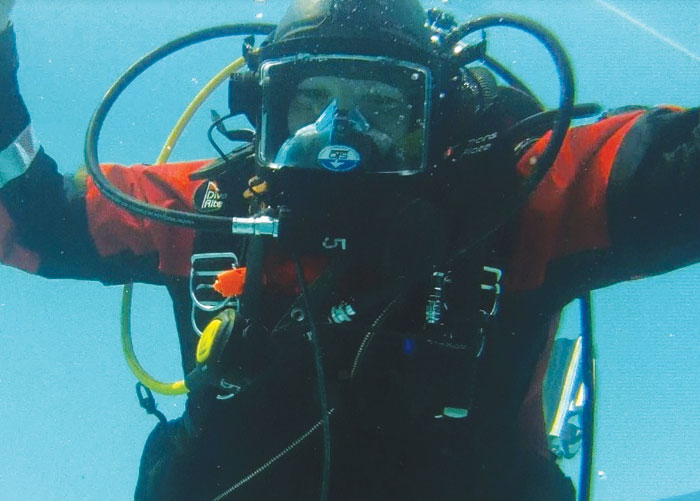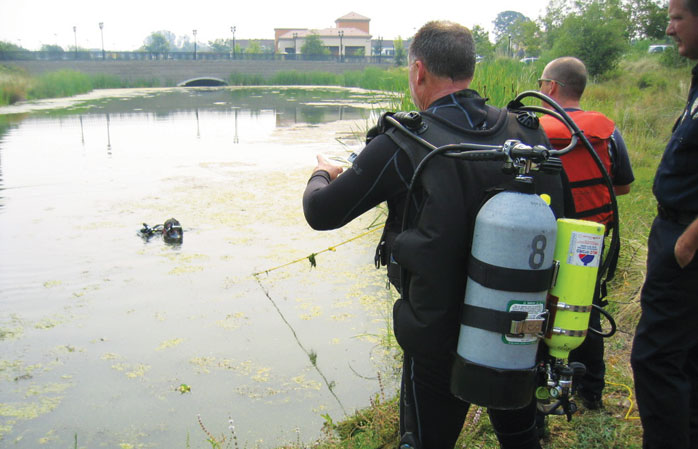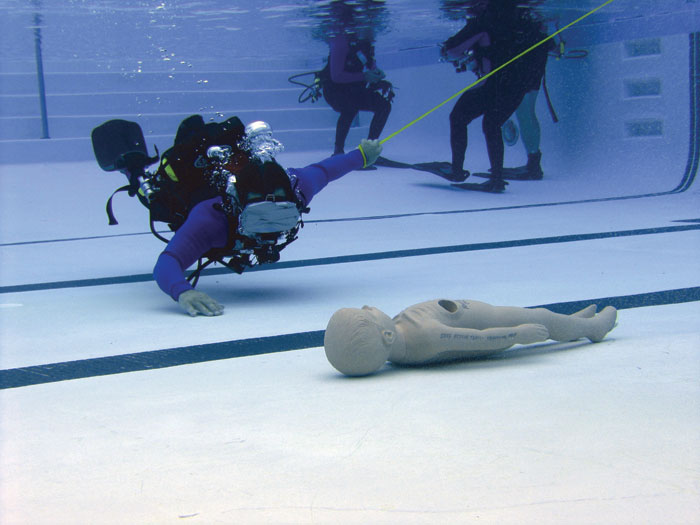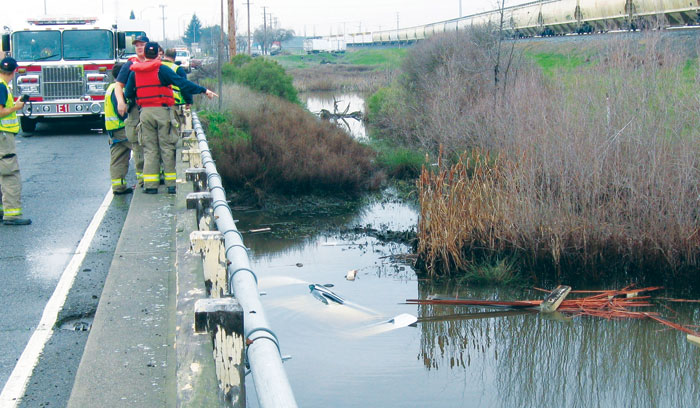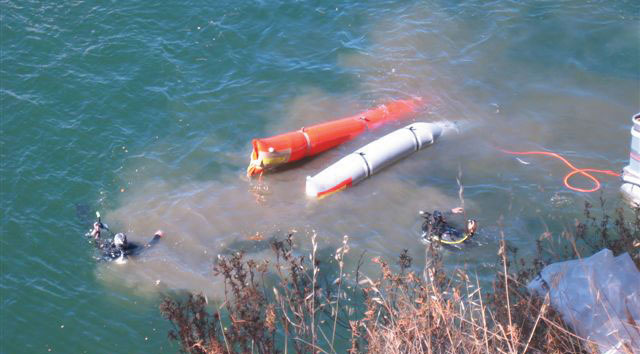Scuba divers and surface-supplied divers perform many important tasks in the underwater world. While recreational divers may specialize in exploring shipwrecks, underwater photography, dive training, or hunting and collecting, commercial divers make their living underwater as military divers, scientific divers, underwater welders, and in dozens of other roles. In addition to these “working divers,” there is another group of specialists that are vitally important in our communities: Public Safety Divers.
Words & Photos by Josh Roten, Dive-SAR.com
Public Safety Divers, or PSDs as they’re often referred to, are dedicated to serving the public by performing underwater search, rescue, recovery, and tactical diving operations. These divers are on-call twenty-four hours a day, seven days a week to respond to emergencies, often in the middle of the night, in extremely difficult environments, and often in zero-visibility conditions. While many begin their training as recreational divers, their additional PSD training prepares them to recover crime-scene evidence, perform underwater crime investigations, and frequently, to recover the bodies of drowning victims. It’s not a job for everyone. Those who choose to become a PSD must dedicate themselves to challenging training, routine dives in difficult conditions, and sometimes very stressful conditions.
This introduction will show you the duties a Public Safety Diver performs, the training involved, and some of the specialized equipment regularly used in public safety diving.
Search
No underwater rescue or recovery operation can begin until the victim(s) or object(s) are located. Accurate, timely, and detailed searches are an extremely important set of tasks PSDs perform.
Planning for nearly all underwater searches begins with obtaining witness information, which, ironically, can also be the start of problems for the PSD. When witnesses are emotional, impaired by alcohol or drugs, or simply not able to note important details about location, time, or conditions, inaccurate information may be relayed to responding divers. That makes establishing an exact “point-last-seen” and “time-last-seen” challenging—and these are critical elements in a successful search. It makes a substantial difference if responding divers can be placed very close to submerged victims, evidence, or stolen property. Dive team members use several techniques to try to assemble an accurate picture of the events. Their speed is affected by factors such as underwater visibility, the size of the object being searched for, bottom composition, silt conditions, moving water, and depth.
Most PSDs begin their training in a swimming pool, learning various search techniques under ideal conditions, and with near-perfect visibility. Next, their masks are taped over, and they repeat the search techniques diving “blind,” simulating zero or near-zero visibility. After completing these blind dives, they repeat this process with their masks still blacked-out, but with additional objects, obstacles, and entanglement hazards, as well. PSDs must learn to assess each object by feel, while avoiding entanglement as they move along in their searches.
Underwater search requires defining search area boundaries and following a well-planned methodology. The variables involved make it easy to be misled, making the process time-consuming and frustrating. And in rescue situations, every second counts.
Rescue
When human victims are the target of a search, the first one-hour of submersion time is called “Rescue Mode.” Rescue Mode is based partly upon the delay of biological death when submerged in cold water (less than 70° F, or 21° C). Medical research and actual case studies of cold-water drowning victims show that some drowning victims have been successfully resuscitated, with no neurological deficits, after being submerged in cold water for an hour (plus or minus a few minutes). The PSD industry standard is to treat all drownings of one hour or less as a rescue. The temperature of the water, the submersion time, and the age of the victim are all important factors in the chances of a successful resuscitation.
To most PSDs, the prospect of being involved in an underwater rescue and saving a human life is strong motivation. Unfortunately, the reality for most PSDs is that they will mainly be involved in recovering bodies instead of saving lives.
Recovery
“Recovery Mode” begins after the first hour of submersion time (when searching for humans), and all searches for anything non-human, such as weapons, evidence, stolen cars, and property. Recovery Mode is just what it sounds like—locating and bringing in any bodies or submerged objects, as well as creating underwater scene documentation, such as sketches, measurements, photographs, videos, and so on.
Tactical
Some PSD teams (usually law-enforcement teams) have the added responsibility of tactical diving, in addition to their roles as search/rescue/recovery divers. Tactical diving has become increasingly important since 9/11, because it includes homeland security duties, as well as law-enforcement issues, such as port/waterfront security, hull searches of vessels entering ports, security checks below the waterline near critical infrastructure and other potential terrorist targets, tactical operations relating to pursuing and apprehending suspects in or near the water, and detecting and intercepting drug and human trafficking. Tactical diving also includes detecting and rendering-safe underwater explosive devices, underwater crime-scene investigation, post-bomb/blast scene investigation, and evidence recovery.
With most PSDs and dive teams, the majority of time on the job is spent planning and training instead of actual operational time. Safety during all operations is always the number one priority, and this is especially important, given that PSDs often dive in conditions that no sport diver would elect to dive in (or should).
Within PSD are important specialties, skills, and levels of training. It is not common for a single PSD, or even a team of them to be experts in every aspect of their craft.
PSDs include community volunteers who donate their time, gear, and diving expertise, as well as members of local sheriff department, fire department, or rescue squad dive teams. Other PSDs are full-time members of fire departments and law-enforcement agencies, who dive in addition to their normal duties. Some state and federal agencies (the FBI, for example) have their own public safety dive teams.
PSDs rarely get to choose the conditions or environments in which they will dive. The decision to dive or not to dive is determined by need and urgency. Common conditions include night diving, bad weather, cold water, contaminated water, high surf, moving water, deep water, zero or near-zero visibility, and areas with obstructions and entanglement hazards. These conditions are considered “the norm” by most PSDs.
While there is no single standard for the minimum requirements for PSD training, there are industry standards for training, policies, and equipment. These standards are based upon the types of public-safety diving the team will be doing, the number and types of bodies of water they can expect to be diving in, and other resources that might be available in the region to assist with dive rescue, recovery, and tactical operations. Common certifications required for PSDs include Advanced Diver, Rescue Diver (the recreational version), and some specific PSD classes focused on advanced searches, rescue mode, and recovery mode diving, as well as handling underwater crime scenes.
Some examples of the knowledge, skills, and abilities needed by PSDs include:
- Exceptional self-control and the ability to remain calm
- Good physical fitness, including a balanced combination of stamina and strength
- Above-average diving skills
- Above-average dive-science knowledge, including precise calculation of air consumption rates, lift-bag capabilities, dive profiles, breathing-gas mixes, and so on
- Ability to work well as part of a team
- Ability to properly assess diving hazards and when to declare a “no-dive” situation
- Thorough understanding of advanced underwater search patterns and procedures
- The ability to deal with locating and recovering bodies underwater
- Knowledge and skills relating to the protection, preservation, documentation, and collection of evidence from possible underwater crime scenes
- The dedication to protecting the public from terrorism and other threats through port and waterfront security measures, and tactical operations
- The ability to professionally and tactfully deal with distressed family and friends of the victims, and inquisitive members of the media
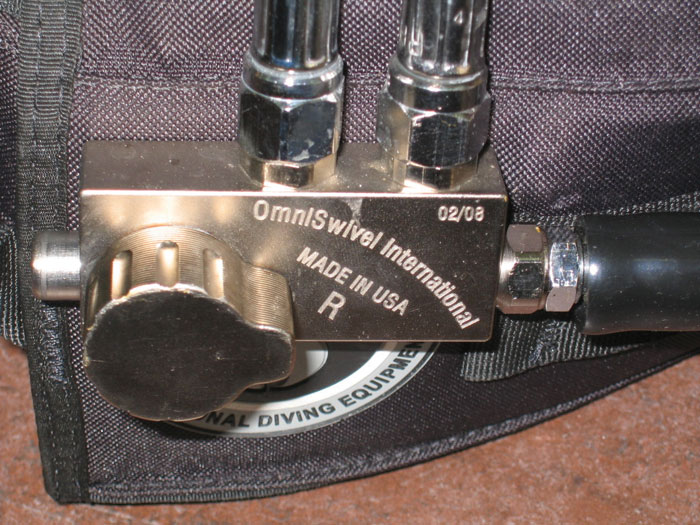
Specialized gear: A gas switching block allows diver to switch from primary air source to backup without removing their full face mask in contaminated water
Public Safety Dive Gear
The gear worn and used by PSDs is dictated by their budgets, the types of environments they expect to be diving in, and the tasks they expect to be performing underwater. Some common examples of specialized gear/equipment used by PSDs include:
- Full-face masks (FFM) with voice communications
- Fully encapsulating dry suits with attached latex hoods and dry gloves
- “Pony” or “bail-out” systems, with an “octo,” or an alternate air source pre-plumbed directly to the full-face mask
- Sidescan sonar
- Underwater metal detectors
- ROVs with lights, cameras, and working “arms”
- Dive boats/platforms
- Helicopters
- Response or support vehicles
- Ropes, lines, and lift bags
- Portable air compressors for filling SCUBA tanks at remote locations
- Surface-supplied Air (SSA)
- Diving helmets
Some PSDs have to supply their own dive gear, while others use gear provided by their employers. Ideally, all dive gear is owned and maintained by the agency, and all divers on a given team are dressed and geared up in exactly the same fashion. This makes helping each other in zero and near-zero visibility environments easier and safer, as well as streamlining maintenance and repair.
Full-face masks and fully encapsulating dry suits should be the minimum safety equipment, since most public-safety diving is done in contaminated water, or around contaminants such as submerged vehicles leaking fluids, or bodies which have been submerged.
Links to PSD-related websites
www.dive-sar.com
www.iadrs.org
www.diverescueintl.com
www.teamlgs.com
www.erdi.com
www.oceantechnologysystems.com
Words & Photos by Josh Roten
Josh Roten has been diving 36 years and is a NAUI Instructor/Specialty Instructor. He is a retired fire captain/dive-rescue team leader and trains public-safety divers in advanced searches, rescue, recovery, salvage, contaminated water diving, current diving, and altitude diving as well as full-face mask and underwater voice communications. He may be contacted by visiting www.dive-sar.com, or josh@dive-sar.com

